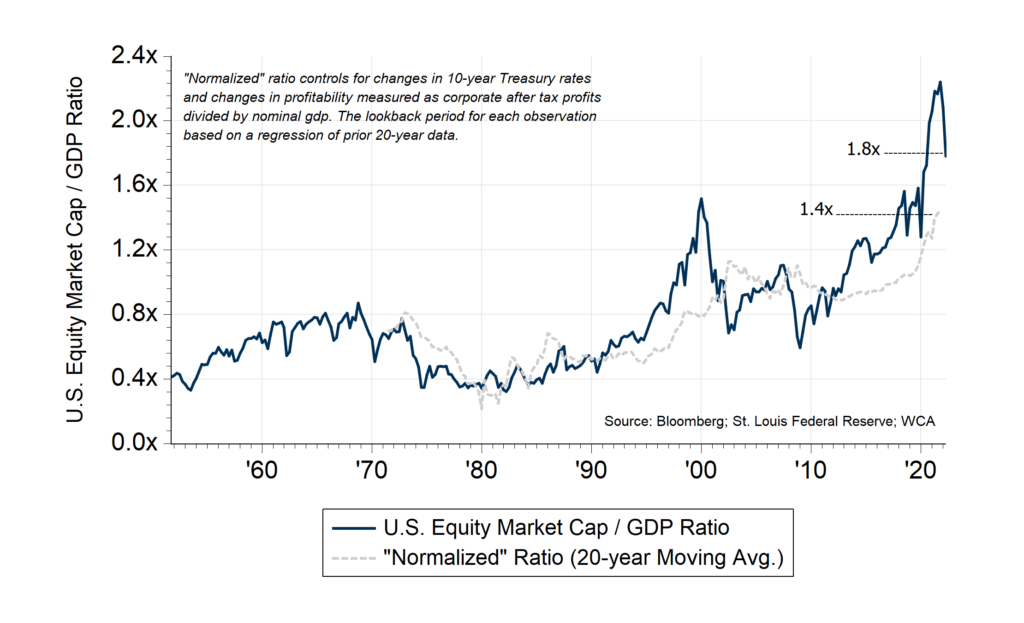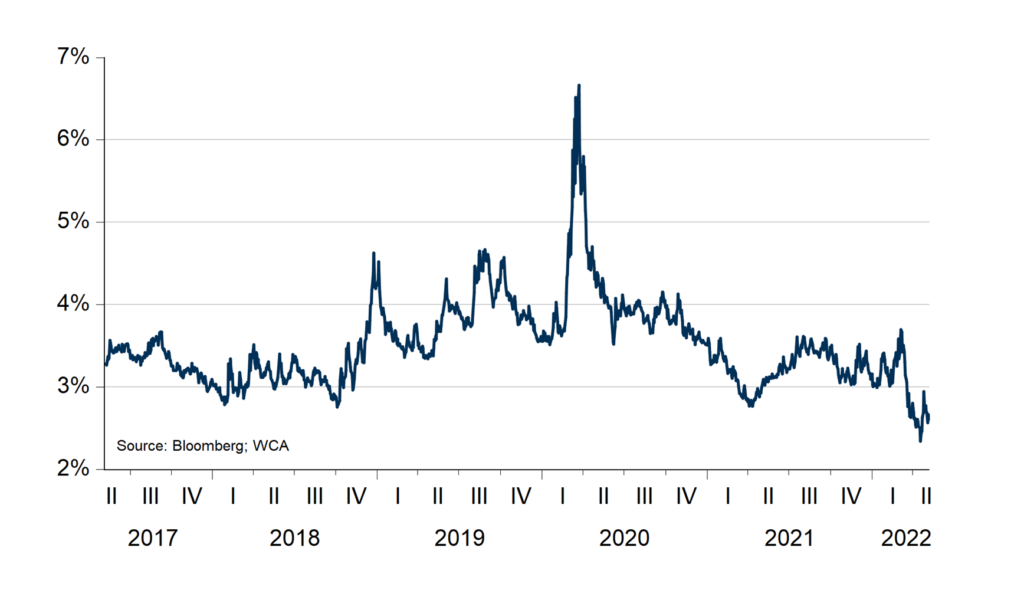Down to Earth?
On the surface, valuations appear to be coming back down to earth. The Standard & Poor’s 500 stock index has declined to nearly 4,000 from almost 4,800 in January. Back at the January peak, forecast year-ahead earnings for the index stood at $223, and now those forecasts are at $237. Today’s price-earnings ratio is 17x compared with 21x in January and in line with the 10-year average. So, stocks are moving down despite rising profit forecasts, resulting in better value.
Valuation Risk
The Federal Reserve (Fed), in its recent “Financial Stability Report,” expressed concern over asset values. According to the report, asset values appeared “elevated.” Moreover, the Fed sees valuations as “high relative to economic fundamentals or historical norms.” The report went on to show that stocks appeared expensive relative to earnings and real estate values were expensive compared to rents.
We agree with this assessment but point out that some adjustments are needed to make comparisons with history more meaningful.
Big Picture
For U.S. stocks, we often compare the total value of domestic corporate equity to the economy’s size. Chart A below shows this relationship since 1950. Immediately, we see that, at 1.8x gross domestic product (GDP), stocks are not cheap. Yet, we must consider two critical factors: interest rates are still low, and profitability is high compared to the past.
The grey line in the graph “normalizes” the effect of low rates and profitability by examining the relationship between stock multiples, interest rates, and profitability over 20-year rolling periods. Even adjusting for these factors, today’s 1.8x multiple appears stretched compared to our “normalized” 1.4x multiple. So, even controlling for these two factors, we still end up with a market that seems expensive.
Chart A
The U.S. Market Cap to GDP Ratio

The Crux of the Matter
Concern over falling profits due to the war in Ukraine or inflation is not the cause of the 800 point decline in the S&P 500 from the January peak. Instead, a combination of rising interest rates and an increase in risk aversion is the crux of the matter. When Treasury rates rise, the bond market offers a more attractive alternative to stocks, all else being equal. Since the start of the year, the 10-year U.S. Treasury yield has jumped to near 3% from 1.75%. Naturally, stock investors are taking a second look at bonds, and the present value of future stock earnings is lower.
Excess enthusiasm has been cooling after throwing caution to the wind the past couple of years. Rising inflation and the Russia-Ukraine war also contribute to more caution among stock investors. A measure of the “equity risk premium” — the extra compensation that investors require for holding stocks relative to Treasury bonds — is still low. We calculate this by subtracting the 10-year Treasury yield from the forward S&P 500 earnings yield (Chart B, below). As you can see, there has been a slight uptick in the equity risk premium, but it remains low compared to the past.
Chart B
Equity Risk Premium

Conclusion
We agree with the Federal Reserve’s assessment that valuations for stocks and other assets appear rich. Moreover, these elevated valuations pose additional economic risks, especially as policy supports are wound down. The Fed’s task of engineering a “soft landing” is complicated by high inflation. Consequently, we believe it is essential to maintain a focus on owning highly flexible, durable, and predictable businesses at reasonable valuations. We hope to address some of the near-term risks that the Federal Reserve’s recent risk assessment points out by sticking with this long-held strategy.
Kevin R. Caron, CFA
Senior Portfolio Manager
973-549-4051
Chad Morganlander
Senior Portfolio Manager
973-549-4052
Matthew Battipaglia
Portfolio Manager
973-549-4047
Steve Lerit, CFA
Senior Risk Manager
973-549-4028
Tom Serzan
Analyst
973-549-4335
Suzanne Ashley
Internal Relationship Manager
973-549-4168
Eric Needham
Director, External Sales and Marketing
312-771-6010
Jeffrey Battipaglia
Client Portfolio Manager
973-549-4031
Disclosures
The information contained herein has been prepared from sources believed to be reliable but is not guaranteed by us and is not a complete summary or statement of all available data, nor is it considered an offer to buy or sell any securities referred to herein. Opinions expressed are subject to change without notice and do not take into account the particular investment objectives, financial situation, or needs of individual investors. There is no guarantee that the figures or opinions forecast in this report will be realized or achieved. Employees of Stifel, Nicolaus & Company, Incorporated or its affiliates may, at times, release written or oral commentary, technical analysis, or trading strategies that differ from the opinions expressed within. Past performance is no guarantee of future results. Indices are unmanaged, and you cannot invest directly in an index.
Asset allocation and diversification do not ensure a profit and may not protect against loss. There are special considerations associated with international investing, including the risk of currency fluctuations and political and economic events. Changes in market conditions or a company’s financial condition may impact a company’s ability to continue to pay dividends, and companies may also choose to discontinue dividend payments. Investing in emerging markets may involve greater risk and volatility than investing in more developed countries. Due to their narrow focus, sector-based investments typically exhibit greater volatility. Small-company stocks are typically more volatile and carry additional risks since smaller companies generally are not as well established as larger companies. Property values can fall due to environmental, economic, or other reasons, and changes in interest rates can negatively impact the performance of real estate companies. When investing in bonds, it is important to note that as interest rates rise, bond prices will fall. High-yield bonds have greater credit risk than higher-quality bonds. Bond laddering does not assure a profit or protect against loss in a declining market. The risk of loss in trading commodities and futures can be substantial. You should therefore carefully consider whether such trading is suitable for you in light of your financial condition. The high degree of leverage that is often obtainable in commodity trading can work against you as well as for you. The use of leverage can lead to large losses as well as gains. Changes in market conditions or a company’s financial condition may impact a company’s ability to continue to pay dividends, and companies may also choose to discontinue dividend payments.
All investments involve risk, including loss of principal, and there is no guarantee that investment objectives will be met. It is important to review your investment objectives, risk tolerance, and liquidity needs before choosing an investment style or manager. Equity investments are subject generally to market, market sector, market liquidity, issuer, and investment style risks, among other factors to varying degrees. Fixed Income investments are subject to market, market liquidity, issuer, investment style, interest rate, credit quality, and call risks, among other factors to varying degrees.
This commentary often expresses opinions about the direction of market, investment sector, and other trends. The opinions should not be considered predictions of future results. The information contained in this report is based on sources believed to be reliable, but is not guaranteed and not necessarily complete.
The securities discussed in this material were selected due to recent changes in the strategies. This selection criterion is not based on any measurement of performance of the underlying security.
Washington Crossing Advisors, LLC is a wholly-owned subsidiary and affiliated SEC Registered Investment Adviser of Stifel Financial Corp (NYSE: SF). Registration with the SEC implies no level of sophistication in investment management.
Disclosures
The information contained herein has been prepared from sources believed to be reliable but is not guaranteed by us and is not a complete summary or statement of all available data, nor is it considered an offer to buy or sell any securities referred to herein. Opinions expressed are subject to change without notice and do not take into account the particular investment objectives, financial situation, or needs of individual investors. There is no guarantee that the figures or opinions forecast in this report will be realized or achieved. Employees of Stifel, Nicolaus & Company, Incorporated or its affiliates may, at times, release written or oral commentary, technical analysis, or trading strategies that differ from the opinions expressed within. Past performance is no guarantee of future results. Indices are unmanaged, and you cannot invest directly in an index.
Asset allocation and diversification do not ensure a profit and may not protect against loss. There are special considerations associated with international investing, including the risk of currency fluctuations and political and economic events. Changes in market conditions or a company’s financial condition may impact a company’s ability to continue to pay dividends, and companies may also choose to discontinue dividend payments. Investing in emerging markets may involve greater risk and volatility than investing in more developed countries. Due to their narrow focus, sector-based investments typically exhibit greater volatility. Small-company stocks are typically more volatile and carry additional risks since smaller companies generally are not as well established as larger companies. Property values can fall due to environmental, economic, or other reasons, and changes in interest rates can negatively impact the performance of real estate companies. When investing in bonds, it is important to note that as interest rates rise, bond prices will fall. High-yield bonds have greater credit risk than higher-quality bonds. Bond laddering does not assure a profit or protect against loss in a declining market. The risk of loss in trading commodities and futures can be substantial. You should therefore carefully consider whether such trading is suitable for you in light of your financial condition. The high degree of leverage that is often obtainable in commodity trading can work against you as well as for you. The use of leverage can lead to large losses as well as gains. Changes in market conditions or a company’s financial condition may impact a company’s ability to continue to pay dividends, and companies may also choose to discontinue dividend payments.
All investments involve risk, including loss of principal, and there is no guarantee that investment objectives will be met. It is important to review your investment objectives, risk tolerance, and liquidity needs before choosing an investment style or manager. Equity investments are subject generally to market, market sector, market liquidity, issuer, and investment style risks, among other factors to varying degrees. Fixed Income investments are subject to market, market liquidity, issuer, investment style, interest rate, credit quality, and call risks, among other factors to varying degrees.
This commentary often expresses opinions about the direction of market, investment sector, and other trends. The opinions should not be considered predictions of future results. The information contained in this report is based on sources believed to be reliable, but is not guaranteed and not necessarily complete.
The securities discussed in this material were selected due to recent changes in the strategies. This selection criterion is not based on any measurement of performance of the underlying security.
Washington Crossing Advisors, LLC is a wholly-owned subsidiary and affiliated SEC Registered Investment Adviser of Stifel Financial Corp (NYSE: SF). Registration with the SEC implies no level of sophistication in investment management.



